Sea turtles have roamed the oceans for approximately 100 million years. They have outlived almost all of the prehistoric creatures with which they once shared the earth. Yet, currently, all seven species of sea turtles are threatened with extinction. The plight of the sea turtle speaks volumes for the health of our oceans and of our planet. If they are in trouble, we are in trouble. To understand this connection, we must take a closer look at why sea turtles are disappearing. By tracking sea turtles and investigating the threats they face, we can understand the bigger picture of what is happening to their ecosystem.
|
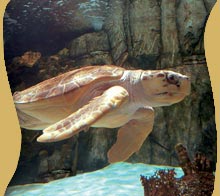 |
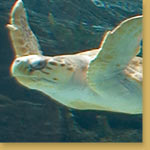 In order to track these elusive animals, researchers are tagging sea turtles with satellite transmitters. Satellite tags transmit location signals to orbiting satellites, which then download the information to a scientist’s computer. For the fourth consecutive year, the WAVE Foundation has partnered with the Marine Turtle Research Group, North Carolina Wildlife Resources Commission and the Bald Head Island Conservancy on a project that follows loggerhead sea turtles in the Western Atlantic. In order to track these elusive animals, researchers are tagging sea turtles with satellite transmitters. Satellite tags transmit location signals to orbiting satellites, which then download the information to a scientist’s computer. For the fourth consecutive year, the WAVE Foundation has partnered with the Marine Turtle Research Group, North Carolina Wildlife Resources Commission and the Bald Head Island Conservancy on a project that follows loggerhead sea turtles in the Western Atlantic.
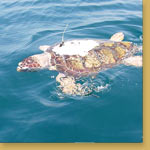 Each year, the WAVE Foundation funds satellite tags to be placed on two nesting females. Once tagged, the turtles are monitored via an innovative, state-of-the-art web site, www.seaturtle.org. Each year, the WAVE Foundation funds satellite tags to be placed on two nesting females. Once tagged, the turtles are monitored via an innovative, state-of-the-art web site, www.seaturtle.org.
Visitors to seaturtle.org are able to follow any of the tagged loggerheads using tracking maps that are updated daily. In 2006, WAVE tagged and named two female loggerheads, Heidi & Kate.

WAVE funds two more satellite tags for sea turtle research.
Check out where our turtles, Heidi and Kate, are now!
Help Tag a Turtle – Your contribution helps
WAVE continue to fund satellite tags in an effort to protect threatened
sea turtles. Each tag and its satellite time costs $5000.00. To
support our Sea Turtle Program, click
here.
Become an adoptive parent to one of WAVE’s sea turtles on www.seaturtle.org.

Found on Bald Head Island as a hatchling in the summer of 1995, Fisher had not been strong enough to make the climb from the nest with his siblings that had made their way to the ocean days prior. North Carolina sea turtle biologists transported the baby turtle to Fort Fisher’s Aquarium where he was given the care he needed to grow strong and healthy.
By January 2003, Fisher had reached 90 pounds and measured over 2 feet in length. Outgrowing his Fort Fisher home, the now sub-adult loggerhead was loaned to the Newport Aquarium to be featured in the Surrounded by Sharks exhibit. During Fisher’s stay in Newport, he was the co-star of the underwater dive show with another loggerhead named Denver.
After a year at the Aquarium, Newport biologists realized that it was time to return Fisher to the wild. A formidable 150 pounds, Fisher would be of great value to the wild loggerhead population, of which only one in thousands survive to adulthood and are able to reproduce. On July 12, 2004, the Newport Aquarium family bid a fond farewell to Fisher when he was tagged with a satellite transmitter and released off the coast of Bald Head Island.
Thousands of people in the tri-state area tracked Fisher’s movements in hopes that he would adapt quickly to life in the Atlantic. The small sea turtle that grew and inspired so many as an Aquarium star, continued to be a messenger for conservation as he crossed the Atlantic Ocean to the African Coast, setting records for his swimming speed. Fisher’s one year journey provided valuable data for researchers and captivated our community as we tracked him across the globe.
|


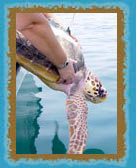

 In order to track these elusive animals, researchers are tagging sea turtles with satellite transmitters. Satellite tags transmit location signals to orbiting satellites, which then download the information to a scientist’s computer. For the fourth consecutive year, the WAVE Foundation has partnered with the Marine Turtle Research Group, North Carolina Wildlife Resources Commission and the Bald Head Island Conservancy on a project that follows loggerhead sea turtles in the Western Atlantic.
In order to track these elusive animals, researchers are tagging sea turtles with satellite transmitters. Satellite tags transmit location signals to orbiting satellites, which then download the information to a scientist’s computer. For the fourth consecutive year, the WAVE Foundation has partnered with the Marine Turtle Research Group, North Carolina Wildlife Resources Commission and the Bald Head Island Conservancy on a project that follows loggerhead sea turtles in the Western Atlantic.  Each year, the WAVE Foundation funds satellite tags to be placed on two nesting females. Once tagged, the turtles are monitored via an innovative, state-of-the-art web site,
Each year, the WAVE Foundation funds satellite tags to be placed on two nesting females. Once tagged, the turtles are monitored via an innovative, state-of-the-art web site, 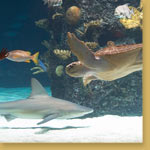 The Story of Fisher
The Story of Fisher